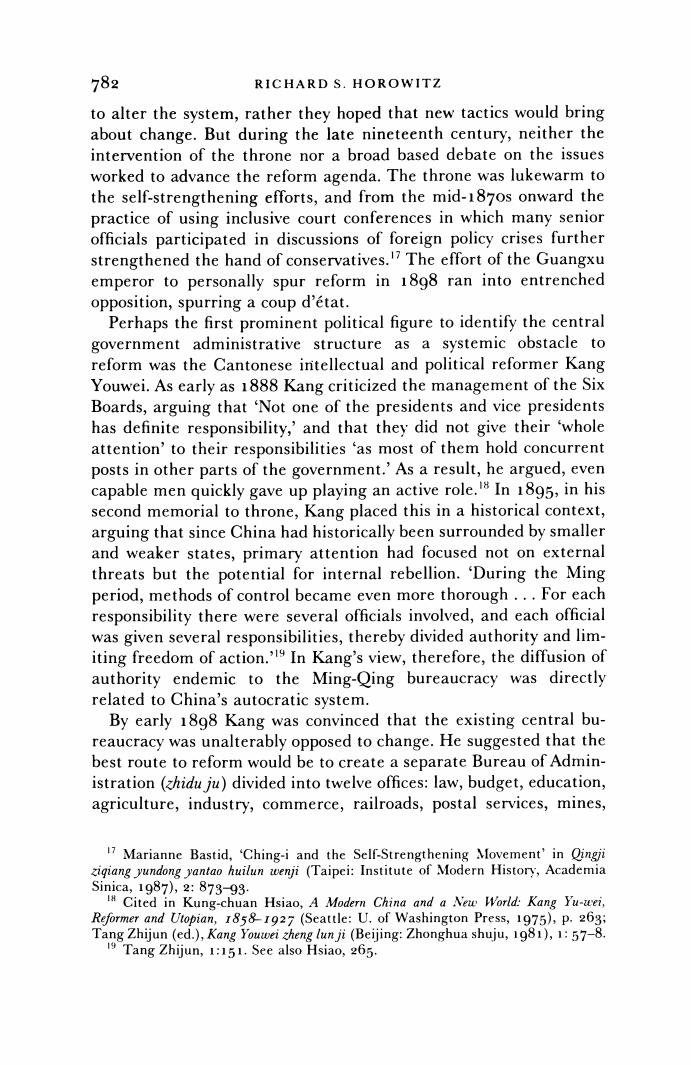正在加载图片...

782 RICHARD S.HOROWITZ to alter the system,rather they hoped that new tactics would bring about change.But during the late nineteenth century,neither the intervention of the throne nor a broad based debate on the issues worked to advance the reform agenda.The throne was lukewarm to the self-strengthening efforts,and from the mid-187os onward the practice of using inclusive court conferences in which many senior officials participated in discussions of foreign policy crises further strengthened the hand of conservatives.7 The effort of the Guangxu emperor to personally spur reform in 1898 ran into entrenched opposition,spurring a coup d'etat. Perhaps the first prominent political figure to identify the central government administrative structure as a systemic obstacle to reform was the Cantonese intellectual and political reformer Kang Youwei.As early as 1888 Kang criticized the management of the Six Boards,arguing that Not one of the presidents and vice presidents has definite responsibility,'and that they did not give their whole attention'to their responsibilities 'as most of them hold concurrent posts in other parts of the government.'As a result,he argued,even capable men quickly gave up playing an active role.In 1895,in his second memorial to throne,Kang placed this in a historical context, arguing that since China had historically been surrounded by smaller and weaker states,primary attention had focused not on external threats but the potential for internal rebellion.During the Ming period,methods of control became even more thorough...For each responsibility there were several officials involved,and each official was given several responsibilities,thereby divided authority and lim- iting freedom of action.'In Kang's view,therefore,the diffusion of authority endemic to the Ming-Qing bureaucracy was directly related to China's autocratic system. By early 1898 Kang was convinced that the existing central bu- reaucracy was unalterably opposed to change.He suggested that the best route to reform would be to create a separate Bureau of Admin- istration (zhidu ju)divided into twelve offices:law,budget,education, agriculture,industry,commerce,railroads,postal services,mines, 17 Marianne Bastid,Ching-i and the Self-Strengthening Movement'in Qingji zigiang yundong yantao huilun wenji (Taipei:Institute of Modern History,Academia Sinica,1987),2:87393. Cited in Kung-chuan Hsiao,A Modern China and a New World:Kang Yu-wei, Reformer and Utopian,18581927(Seattle:U.of Washington Press,1975),p.263: Tang Zhijun (ed.),Kang Youwei zheng lun ji (Beijing:Zhonghua shuju,1981),1:57-8. 1 Tang Zhijun,1:151.See also Hsiao,265.782 RICHARD S. HOROWITZ to alter the system, rather they hoped that new tactics would bring about change. But during the late nineteenth century, neither the intervention of the throne nor a broad based debate on the issues worked to advance the reform agenda. The throne was lukewarm to the self-strengthening efforts, and from the mid-187os onward the practice of using inclusive court conferences in which many senior officials participated in discussions of foreign policy crises further strengthened the hand of conservatives." The effort of the Guangxu emperor to personally spur reform in 1898 ran into entrenched opposition, spurring a coup d'etat. Perhaps the first prominent political figure to identify the central government administrative structure as a systemic obstacle to reform was the Cantonese iritellectual and political reformer Kang Youwei. As early as 1888 Kang criticized the management of the Six Boards, arguing that 'Not one of the presidents and vice presidents has definite responsibility,' and that they did not give their 'whole attention' to their responsibilities 'as most of them hold concurrent posts in other parts of the government.' As a result, he argued, even capable men quickly gave up playing an active role.'8 In 1895, in his second memorial to throne, Kang placed this in a historical context, arguing that since China had historically been surrounded by smaller and weaker states, primary attention had focused not on external threats but the potential for internal rebellion. 'During the Ming period, methods of control became even more thorough ... For each responsibility there were several officials involved, and each official was given several responsibilities, thereby divided authority and limiting freedom of action."9 In Kang's view, therefore, the diffusion of authority endemic to the Ming-Qing bureaucracy was directly related to China's autocratic system. By early 1898 Kang was convinced that the existing central bureaucracy was unalterably opposed to change. He suggested that the best route to reform would be to create a separate Bureau of Administration (zhiduju) divided into twelve offices: law, budget, education, agriculture, industry, commerce, railroads, postal services, mines, 7 Marianne Bastid, 'Ching-i and the Self-Strengthening Movement' in Qingji ziqiangyundongyantao huilun wenji (Taipei: Institute of Modern History, Academia Sinica, 1987), 2: 873-93. 18 Cited in Kung-chuan Hsiao, A Modern China and a New World: Kang Yu-wei, Reformer and Utopian, 1858-1927 (Seattle: U. of Washington Press, 1975), p. 263; Tang Zhijun (ed.),Kang Youwei zheng lunji (Beijing: Zhonghua shuju, 1981), 1: 57-8. 19 Tang Zhijun, 1:151. See also Hsiao, 265